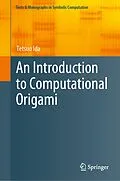In this book, origami is treated as a set of basic geometrical objects that are represented and manipulated symbolically and graphically by computers. Focusing on how classical and modern geometrical problems are solved by means of origami, the book explains the methods not only with mathematical rigor but also by appealing to our scientific intuition, combining mathematical formulas and graphical images to do so. In turn, it discusses the verification of origami using computer software and symbolic computation tools. The binary code for the origami software, called Eos and created by the author, is also provided.
Klappentext
In this book, origami is treated as a set of basic geometrical objects that are represented and manipulated symbolically and graphically by computers. Focusing on how classical and modern geometrical problems are solved by means of origami, the book explains the methods not only with mathematical rigor but also by appealing to our scientific intuition, combining mathematical formulas and graphical images to do so. In turn, it discusses the verification of origami using computer software and symbolic computation tools. The binary code for the origami software, called Eos and created by the author, is also provided.
Inhalt
Introduction to origami.- Origami geometry and basic folds.- Algebra of folds.- Origami geometry vs. Euclid geometry.- Examples.- Origami theorems and verification.- Extensions of basic folds.- Three-dimensional origami.
